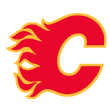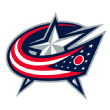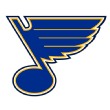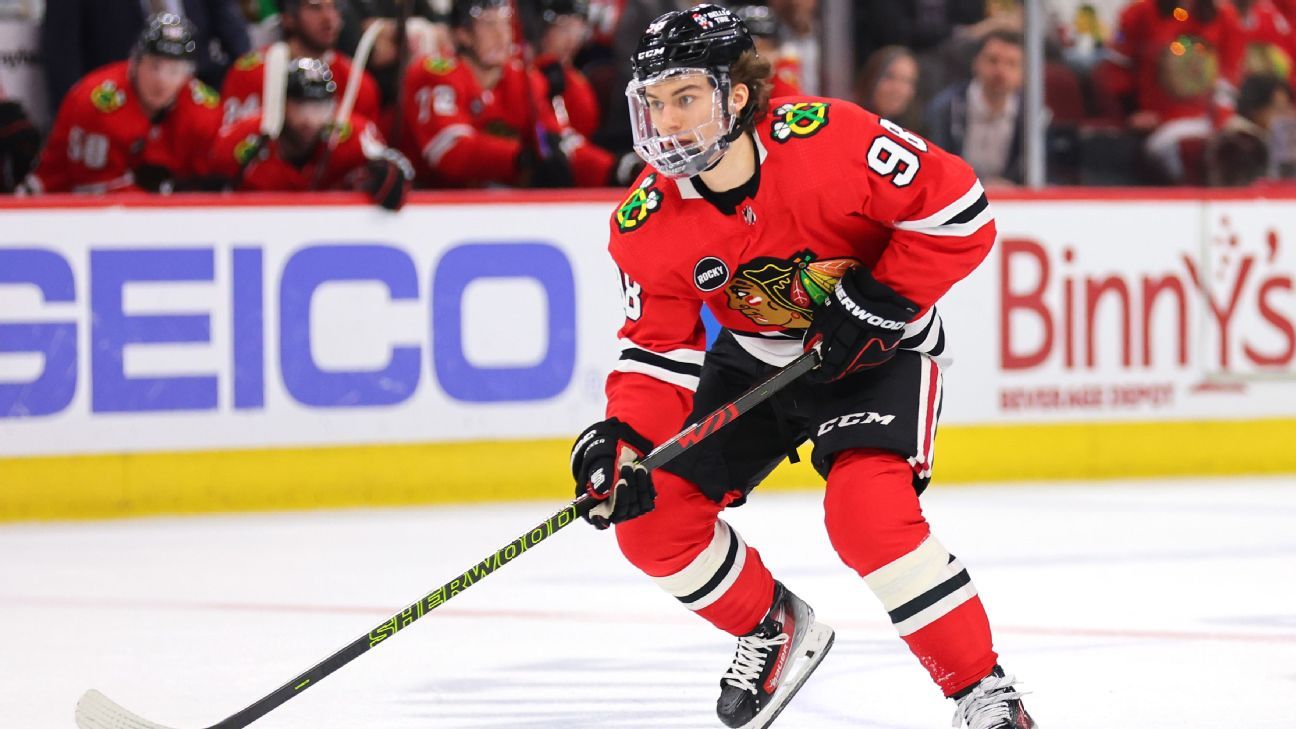The 2023-24 NHL regular season was an entertaining one, with races for playoff position, point and goal leaders, and major trophies all coming down to the bitter end.
But not every fan base got to enjoy all of it so much.
With eliminations piling up, it’s time to look ahead to the offseason. Clubs that didn’t quite hit the mark this season will use the draft, free agency and trades in an effort to be more competitive in 2024-25.
Read on for a look at what went wrong for each eliminated team, along with a breakdown of its biggest keys this offseason and realistic expectations for next season. Note that more teams will be added to this story as they are eliminated.
Note: Profiles for the Atlantic and Metro teams were written by Kristen Shilton, while Ryan S. Clark analyzed the Central and Pacific teams. Stats are collected from sites such as Natural Stat Trick, Hockey Reference and Evolving Hockey. Projected cap space per Cap Friendly.
Jump to a team:
ANA | ARI | BUF | CGY
CHI | CBJ | MIN | MTL
NJ | OTT | SJ
SEA | STL

Non-playoff teams

Projected 2024-25 cap space: $33,755,833
2024 draft picks: 1st, 1st (EDM), 2nd, 2nd (BOS), 3rd, 3rd (PIT), 3rd (SJ), 4th, 6th
What went wrong?
Young teams are going to lose games. What hindered the Ducks is that their defeats came in bunches. An eight-game losing streak in November set the stage for a five-game losing streak in early December. There was the four-game losing streak to start the new year. They had a pair of three-game skids in January and February before going on a six-game losing streak to start March and then losing five straight to end the month.
Injuries didn’t help the Ducks either — especially when it came to Trevor Zegras. The two-time 60-point scorer sustained a lower-body injury in early November that saw him miss 20 games before he suffered a broken ankle in January that was slated to keep him out of the lineup for six to eight weeks. The day the Ducks announced they’d be without Zegras, they lost rookie defenseman Pavel Mintyukov for six weeks because of a separated shoulder. Plus, rookie center Leo Carlsson missed time with a sprained knee.
Looking at the stats, the Ducks struggled in both zones. They finished in the bottom five of shots per 60 minutes, fewest goals scored per 60, fewest scoring chances per 60 and fewest high-danger chances per 60. They were also in the top 10 of most shots allowed per 60, most goals allowed per 60 and most high-danger chances allowed per 60.
Keys to the offseason:
Finishing with one of the worst records in the league means the Ducks are among the main entrants in the Macklin Celebrini sweepstakes. Winning the draft lottery would give them their center tandem of the future in Celebrini and Carlsson, whom they selected with the No. 2 pick of the 2023 draft.
They have four picks in the first two rounds and seven through the first three rounds. Drafting Celebrini would be the centerpiece of those plans. But even if the Ducks don’t win the lottery, they can still use this draft to add to what’s already considered one of the most promising systems in the NHL.
Rookie defenseman Jackson Lacombe is part of a seven-player RFA class, while their major UFA Jakob Silfverberg is retiring. It leaves the Ducks with what Cap Friendly projects to be nearly $34 million in cap space. Having that much space could allow the Ducks to strengthen their roster with the expectation that they’ll see improvement in Year 2 under coach Greg Cronin.
Realistic expectations for 2024-25:
The Ducks are not a team that’s ready to challenge for a playoff spot in the extremely crowded Western Conference. But the progress they saw from a rookie class that featured Carlsson, Lacombe, Mintyukov and Olen Zellweger suggests the next step for the Ducks is to find the consistency that can see them avoid having a third straight season near the bottom of the league standings.

Projected 2024-25 cap space: $41,245,357
2024 draft picks: 1st, 2nd, 2nd (FLA), 2nd (WSH), 3rd, 3rd (COL), 3rd (EDM), 4th, 4th (SJ), 5th, 6th, 6th (DAL), 7th
What went wrong?
Last offseason, some believed this team would be at least on the fringes of contention for a playoff spot. The Coyotes were among the challengers for one of the two Western Conference wild-card positions until Jan. 24. That’s the day they lost the first of what would be 14 consecutive games.
That losing streak saw the Coyotes go from being two points behind in the race for the final wild-card spot to being 19 points back by their next victory. The timing of the streak was also such that it all but ensured the front office would be trading players away in exchange for futures.
The season that started with promise due in part to offseason acquisitions such as Matt Dumba and Jason Zucker meant parting with those two players at the trade deadline. It also left the Coyotes to wonder what could have been if not for such a calamitous month of February.
Keys to the offseason:
Beyond their move to Salt Lake City, it appears there are a number of items the Coyotes could address. It starts with finding new contracts for a defensive unit that has all seven of its members in need of a new deal. That includes J.J. Moser, who is one of five RFA defensemen on the roster.
Another item the Coyotes could address is how to further supplement a core that appears to be on the verge of contention. Lawson Crouse hit the 20-goal mark for a third straight season. Clayton Keller had his second straight 30-goal campaign, and Nick Schmaltz also scored 20 for a third season in a row — setting a new career high in points. Combining what they did with the progress made by Logan Cooley, Josh Doan and Dylan Guenther and Matias Maccelli, one wonders what this core could do with some help.
One of the ways the Coyotes could reach their desired destination could be to replicate what they did in free agency last summer. Part of that was parlaying their cap space into trades with cap-strapped teams, while also signing free agents to one-year deals knowing they could move them ahead of the deadline if necessary. They could use that approach to once again to strengthen certain areas of their roster while having one eye on the playoffs and another on attaining more draft capital if it comes to that point.
Realistic expectations for 2024-25:
If the Coyotes can get the necessary reinforcements, there’s a chance they could pose a stronger challenge for a playoff spot in their first season in Utah. If not, then they might once again be stuck in that mushy middle of not quite good enough for a playoff spot and not quite poor enough to be in the running for a top-three pick.

Projected 2024-25 cap space: $22,243,930
2024 draft picks: 1st, 2nd, 3rd, 4th, 4th (PHI), 6th, 7th, 7th (FLA)
What went wrong?
The Sabres were supposed to end their infamous playoff drought — the longest current run in North American sports — by picking up where they left off last season as a confident club on the rise fueled by a particularly potent offensive attack.
And then, the season actually started.
Before that, though, the Sabres learned Jack Quinn would miss half the season with an Achilles tendon injury. That was blow No. 1. Tage Thompson, Alex Tuch, Jordan Greenway and Zemgus Girgensons missing time with various ailments made things worse. But health was hardly Buffalo’s largest problem — the Sabres simply couldn’t score at anywhere close to the rate they did a season ago. Outside of Buffalo’s top players — the likes of Thompson, Jeff Skinner, Tuch and a breakout showing from JJ Peterka — there was no secondary help (and Dylan Cozens all but disappeared), while the Sabres’ inconsistent defensive showings made it hard to win games. The power play was naturally impacted by the lack of scoring touch, ranking 28th overall (16.7%).
It also took too long for Buffalo to find its goaltending groove. Devon Levi didn’t take control of the crease as expected, and by the time Ukko-Pekka Luukkonen stepped up with a remarkable second half it was too little, too late for Buffalo to rally and make the playoffs. Luukkonen should be a bright spot in the Sabres’ future, though, and that’s something they can cling to heading into the offseason.
Keys to the offseason:
The Sabres have worked hard to put a strong foundation in place. This offseason will require GM Kevyn Adams to, once again, fit the right complementary players around the team’s core. Adams already started on that when he moved Casey Mittelstadt at the trade deadline to acquire Bowen Byram. Buffalo now has one of the most enviable young defense corps (highlighted by Byram, Rasmus Dahlin, Owen Power and others) in the NHL and that should hold the team in good standing going into next season. And as mentioned, Luukkonen should hold the inside track on Buffalo’s starting job.
So what else can Adams do at this stage — having already paid and extended a handful of difference-makers — to improve the Sabres’ prospects? That question will drive his approach — and it must include assessing whether Don Granato is still the right coach to carry the franchise to its desired destination.
There’s a need for veteran depth, though. And consistent players at that. Trading captain Kyle Okposo cost the Sabres a critical voice in their locker room, and deciding who will succeed Okposo with the “C” is another matter potentially addressed over this summer.
Realistic expectations for 2024-25:
Buffalo managed to stay in the playoff hunt for most of this season despite its many flaws and general underperformance. Could that be a good sign? Again, the Sabres’ core is strong. It’s what’s missing around the edges that has held Buffalo back from reaching its full potential. An aggressive offseason by Adams might be the Sabres’ ticket out of playoff purgatory. That should be where everyone’s sights are set when another new season begins.

Projected 2024-25 cap space: $18,699,167
2024 draft picks: 1st, 1st (VAN), 2nd, 2nd (DAL), 3rd, 3rd (VGK), 4th, 4th (NJ), 6th
What went wrong?
Finishing three points behind the Jets for the final Western Conference wild-card spot last season created the belief the Flames could be a playoff team. But that came with the understanding that getting to the postseason could prove challenging given the uncertainty around their roster.
Uncertainty was also a way to describe this Flames season as a whole. On one hand, they had five sequences in which they won more than three games in a row — creating questions about whether they could land a playoff spot. On the other hand, they had seven occasions during which they lost more than three games in a row — which effectively answered the questions about their playoff chances.
Those performances served as a backdrop for a season that saw them trade pending free agents Elias Lindholm, Noah Hanifin and Chris Tanev to Cup contenders, reinforcing the notion that the Flames are more focused on the future.
Keys to the offseason:
The Flames could use the next few months to become the latest team to do a quick retool and get right back to the playoffs next season.
Defenseman Oliver Kylington is their most notable UFA, while goaltender Dustin Wolf leads a four-member RFA class. The Flames have eight players with more than two years remaining on their current contracts, so they do have a core in place.
How should they build around that core? They have eight picks in the first four rounds this year, so that could provide options. It’s possible the Flames could use those picks to strengthen their farm system, or they could use them in trade for some veteran help.
If they elect to go the trade route, they’ll have to be strategic with their decisions as Cap Friendly projects the Flames with less than $19 million in cap space.
Realistic expectations for 2024-25:
It would not be shocking if the Flames returned to the playoffs. It would not be shocking if they took another step back in service of the rebuild. It all depends on how the front office approaches things.

Projected 2024-25 cap space: $38,334,167
2024 draft picks: 1st, 1st (TB), 2nd, 2nd (LA), 2nd (VAN), 3rd, 3rd (OTT), 5th (NSH), 6th
What went wrong?
Being the young team that gradually challenges for a playoff spot could someday be the hope for the Blackhawks. They’re just not there yet, and that was the reality of 2023-24. Their current situation meant practically everything about this season was going to be centered around Connor Bedard and where things stood with the franchise’s rebuild.
Part of the strategy behind supporting Bedard and the Blackhawks’ young core was to surround him with veterans such as Nick Foligno, Taylor Hall and Corey Perry. Hall sustained a right knee injury that required season-ending surgery, while Perry was released after an investigation into misconduct.
Even with all that, Bedard used this season to show he could handle the demands of being a top-line center. He led the Blackhawks in goals, assists and points, and also led all forwards in ice time at nearly 20 minutes per game. His performances — along with the contributions of Jason Dickinson, Kevin Korchinski, Philipp Kurashev and Alex Vlasic — saw the Hawks take a step toward their next contention window.
Keys to the offseason:
Can they win the draft lottery for a consecutive season and get Boston University center Macklin Celebrini? Winning the lottery would give the Blackhawks two cornerstone centers in Bedard and Celebrini, which would create even more expectations about what the Blackhawks could look like in the years to come.
Even if they don’t win the lottery, the Blackhawks still have the draft capital to help strengthen what they believe to be a bright future. They have five picks in the first two rounds, and seven picks in the first three rounds. It’s the sort of stockpile they can use to either draft more high-level talent or trade to get a player who can help them right now.
As for their current roster, Cap Friendly projects the Blackhawks will have more than $38 million in cap space. That can be used to address a RFA class that includes Vlasic, in addition to strengthening a defense that has three pending UFAs in Jaycob Megna, Jarred Tinordi and Nikita Zaitsev. Plus, the Blackhawks could also sign a few players on cheap contracts they could move ahead of the 2024-25 trade deadline to gain more draft capital if they remain outside the playoff mix.
Realistic expectations for 2024-25:
The development of their high-level young players is the mission for the Blackhawks. Winning the lottery, drafting Celebrini and getting him to leave BU after one season would be a massive step forward in their future plans. Even then, it would come with the understanding that the Blackhawks need more time before taking the next step as a team trying to challenge for the playoffs.

Projected 2024-25 cap space: $20,792,500
2024 draft picks: 1st, 3rd, 3rd (LA), 4th, 5th, 6th
What went wrong?
There was hope this season might be different, but Columbus is missing the playoffs for a fourth straight season. The team got off to an inauspicious start before even playing its first game, thanks to Mike Babcock’s quick exit, leading to first-time NHL head coach Pascal Vincent taking over. Then Columbus’ real problems began.
The new season opened with Columbus winning three of its first five tilts — and then losing 13 of the next 14. Johnny Gaudreau, that highly prized free agent the Blue Jackets pegged as a savior, had arguably the worst season of his career with 11 goals and 58 points in 77 games. But he was still, bafflingly, Columbus’ leading scorer (the Blue Jackets’ second most productive forward? Kirill Marchenko, with 39 points). The Blue Jackets landed near the bottom of the league in every offensive, defensive and special teams category. Plus, two of the three goalies Columbus primarily used (with a minimum of five starts) have a sub-.900 save percentage. It’s a recipe for disaster.
Granted, Columbus dealt with staggeringly poor health across the board. The Blue Jackets racked up approximately 250 man games lost to injury, including to 2023 No. 3 overall pick Adam Fantilli (leg), forward Sean Kuraly (lower body), Justin Danforth (concussion) and defenseman Adam Boqvist (upper body). Patrik Laine also missed time early in the season with a broken clavicle prior to entering the NHL/NHL Player Assistance Program in January. Columbus tried to make the most of who it had in the lineup, but, as in years past, the sheer volume of injuries (among other problems) was once again insurmountable.
Keys to the offseason:
The Blue Jackets must do an internal review on how and why they are among the NHL’s most injured teams every season. It’s uncanny how many of Columbus’ most important, impactful players wind up missing large stretches of the season. If there’s a way the club can reduce that through new training protocols or regimens it would go a long way in making the Blue Jackets competitive again.
That said, Columbus’ search for a new general manager is a top priority. Longtime GM Jarmo Kekalainen was fired in February and president of hockey operations John Davidson has been filling in temporarily. He will eventually spearhead the Blue Jackets’ efforts in identifying and hiring the right person to put the club back on a winning track. What exactly that looks like for Columbus is the critical question.
Will the Blue Jackets pursue a full-scale rebuild or attempt to capitalize on their core of young talents — namely Fantilli, Dmitri Voronkov, Marchenko, Cole Sillinger, David Jiricek and others — to push their way into an immediately brighter future? Then there’s Elvis Merzlikins. The Blue Jackets starter has three seasons left on his contract at $5.4 million per year and won’t be easy to trade with a full no-movement clause. But a fresh start for him outside Columbus might be best for both player and team. Keep an eye on how that situation potentially plays out in the coming months.
Realistic expectations for 2024-25:
It seems unlikely Columbus can go from bottom-dweller to playoff contender in a single season. But at least putting themselves in the mix would be a massive boost for the Blue Jackets and the confidence of their array of burgeoning players. They need to know the organization has a plan. Whatever that ultimately is should be decided quickly and executed by a management team installed for the long haul.

Projected 2024-25 cap space: $7,724,746
2024 draft picks: 1st, 2nd, 4th, 5th, 5th (BUF), 6th
What went wrong?
There were early hints that the 2023-24 season was going to be a challenging one for the Wild. Turns out it was. They opened the season by losing 14 of their first 19 games. That led to them firing Dean Evason and hiring John Hynes. Even though the coach switch led them to get back into the wild-card race, they could not overcome a series of injury issues.
Look no further than what happened to them in January. At one point, they were without Jonas Brodin, Marcus Foligno, Filip Gustavsson, Kirill Kaprizov, Jared Spurgeon and Mats Zuccarello. Everyone but Spurgeon would return, with the Wild captain being ruled out for the rest of the season in mid-January.
All those challenges were further compounded by an inability to consistently score goals. The Wild were in the bottom third in shots per 60 minutes in 5-on-5 play, goals per 60 at 5-on-5 and scoring chances per 60 at 5-on-5.
Keys to the offseason:
Figuring out numerous ways to be creative with cap space has been one of the hallmarks of Bill Guerin’s time as the Wild’s general manager. It appears that could be the case this offseason with Cap Friendly projecting the Wild will have a little more than $7.7 million in cap space, even with veterans such as Alex Goligoski and Marc-Andre Fleury becoming UFAs.
What helps is that players such as Brock Faber, Marco Rossi and Jesper Wallstedt, who could be used in tandem with Filip Gustavsson to replace Fleury next season, are all on their entry-level contracts.
Maximizing those savings could allow the Wild to get the help they need knowing that Faber, Rossi and Wallstedt will need new contracts at the same time the club gets most of the $14.743 million off its books from the combined Zach Parise and Ryan Suter buyouts following 2024-25.
Realistic expectations for 2024-25:
Is a return to the playoffs following a one-year hiatus realistic? Yes. But there is a ton of competition in the West. Seeing what this team looks like — and if it can maintain some of the bouts of success it had once Hynes took over — will be fascinating in the fall.

Projected 2024-25 cap space: $9,183,750
2024 draft picks: 1st, 1st (WPG), 2nd (COL), 3rd, 3rd (MIN), 4th, 5th, 5th (SJ), 6th, 7th, 7th (EDM), 7th (WSH)
What went wrong?
Montreal was cooked practically from the start. That’s what happens when a top-line center like Kirby Dach suffers a season-ending knee injury in the first period of his team’s second game. It was a bad omen for the Canadiens, who would be repeatedly derailed by health woes. After Dach went down, it was Alex Newhook — acquired in the offseason to bolster Montreal’s forward depth — landing on IR with a high ankle sprain. Christian Dvorak followed with a torn pectoral. Montreal languished without three of its centers, and the club’s overall offense suffered accordingly.
How badly? Well, the Canadiens wound up averaging just 2.72 goals per game, putting them 27th overall, and their power play was poor (17%, 26th overall). Nick Suzuki was the Canadiens’ only consistent scoring threat and paced the team with 33 goals and 74 points in 77 games; after that was a steep drop-off in output that doomed Montreal time and again. Collectively, the Canadiens scored the sixth-fewest goals at 5-on-5 and never truly found a rhythm up front to sustain them for any stretch.
Montreal’s three-goalie strategy also didn’t pan out. That is, until GM Kent Hughes finally shipped Jake Allen to New Jersey at the deadline and allowed Cayden Primeau and Sam Montembeault to finally settle in as a twosome. Montreal’s porous defense (allowing the third-most shots on goal and seventh-most goals) didn’t help its netminders thrive, either. Add to it all a misfiring penalty kill (at 76.4%) and there weren’t many positive takeaways for Montreal in a season that felt more like standing still instead of stepping forward.
Keys to the offseason:
Montreal’s work begins at the NHL draft. The Canadiens are fortunate to have plenty of capital — including two first-round picks among their 12 total selections — so there’s an opportunity there to either continue stocking up on top prospects or use the picks in trades for players in an immediate position to contribute.
Montreal does have a deep pool of prospects already waiting for their NHL shot. Skaters like Lane Hutson and Filip Mesar are waiting in the wings to shepherd the Canadiens into their next era. Plus, there’s Juraj Slafkovsky‘s continued development to consider. Montreal’s first overall pick in 2022 put an injury-riddled rookie season behind him to be a top-line player with Suzuki and Cole Caufield in his sophomore year. If that trajectory continues then the Canadiens should have a potent unit to lean on next season. And if Montreal has to part with veterans like Brendan Gallagher to make room in the lineup? Hughes can’t hesitate to explore those options.
Beyond that, Montreal’s priority should be defining what success looks like at this stage of its rebuild. The Canadiens have their coach in Martin St. Louis, a collection of young talent eager for more responsibility and a solid management team in place. But it’s time, at last, to start moving the needle and pushing up the standings.
Realistic expectations for 2024-25:
The Canadiens don’t feel too far away. Montreal’s whole season might have been different had Dach and Newhook remained healthy. It’s conceivable Montreal is in the playoff mix next season if, as mentioned, Hughes can construct a roster groomed and ready with an expectation to win now. Is that what the Canadiens want, though? By now, it should be.

Projected 2024-25 cap space: $21,312,500
2024 draft picks: 1st, 3rd, 3rd (WPG), 5th, 5th (COL), 6th
What went wrong?
New Jersey imploded in most every respect — and entirely crumbled under the heightened expectations.
The Devils were last season’s darlings, exceeding expectations in the regular season and advancing to a second-round playoff series. That should have set New Jersey up for another strong season, but the Devils were a shadow of their former selves. New Jersey’s defense was lost without Damon Severson and Ryan Graves, then a long-term injury to Dougie Hamilton sank the group even further. Those blue-line deficiencies only spotlighted New Jersey’s poor goaltending as Vitek Vanecek severely regressed and neither Nico Dawes nor Akira Schmid provided any sustainable relief.
The Devils were porous no matter what combinations coach Lindy Ruff rolled out, and eventually that cost Ruff his job. But New Jersey took too long replacing Ruff with Travis Green; the season was already over.
It wasn’t only New Jersey’s back end causing issues. The Devils weren’t scoring like they did a season ago, either. Jesper Bratt was good with 79 points in 78 games and Jack Hughes — when healthy — produced top-tier totals (74 points in 62 games). But Nico Hischier and Timo Meier were often too average (and both dealt with injuries) while the Devils’ rush attack was muted. There wasn’t close to enough complementary scoring to mask the team’s overall defensive deficiencies. If it weren’t for New Jersey’s eye-popping power play carrying it through the first half, the Devils might have fallen faster than they did down the standings.
Keys to the offseason:
New Jersey will likely want to burn the tape on this season and believe it was a one-off that can be remedied by smart decision-making in the offseason.
The Devils’ first order of business will be either removing the interim head coach tag from Green or selecting someone else for the job. Identifying the right voice who projects to stick around and guide the Devils’ core from here is a top priority.
New Jersey’s other major need is finding its next starting goaltender. GM Tom Fitzgerald grabbed Jake Allen at the deadline (and got rid of Vanecek in the process), but Allen isn’t going to be the solution there. There must be a wide search for someone with veteran pedigree. How Fitzgerald fills that void could make or break another season for the Devils.
After that, though, New Jersey should be looking inward and asking why the team — and too many of its key skaters — took steps back. Getting Hughes healthy after he ended the season with an injury will be crucial.
Realistic expectations for 2024-25:
New Jersey essentially let this season slip away all on its own. If that disappointment doesn’t light a fire under the Devils to push back into being a postseason contender next season, nothing will. New Jersey is too stacked with talent not to be among the Metropolitan’s best.

Projected 2024-25 cap space: $12,815,953
2024 draft picks: 1st, 1st (BOS), 2nd, 4th, 4th (DET), 4th (FLA), 4th (TB), 5th
What went wrong?
What didn’t go wrong for Ottawa this season? Because of all the up-and-coming Eastern Conference clubs projected to make hay in 2023-24, it was the Senators falling, perhaps, most spectacularly short of the mark in nearly all respects.
Ottawa has made offseason signings that simply aren’t panning out as expected. Vladimir Tarasenko was the outlier there; he came in this season to put up 17 goals and 41 points in 57 games before being traded to Florida. Totally fine. Dominik Kubalik‘s sophomore season with the Senators was awful, though — 15 points in 72 games? Ouch — and Joonas Korpisalo wasn’t very good (with an .890 save percentage and 3.27 goals-against average) after signing a five-year deal in the summer. Even Jakob Chychrun was a defensive liability this season, to the point that his offensive gains couldn’t even mask it.
That spoke to a larger issue for Ottawa too, in that the Senators’ collective defensive efforts (highlighted by Thomas Chabot‘s struggles) were shoddy at best (ranking the team top five in goals allowed) and led to such a dismal first half of the season it forced coach DJ Smith out the door (to be replaced by Jacques Martin). Abysmal special teams — both the Senators’ power play and penalty kill ranked among the league’s bottom 10 all season — were another glaring issue.
Despite Ottawa’s continuous attempts to stop the bleeding (which truly began with general manager Pierre Dorion being ousted in November), there was no coming back. Tim Stutzle failed to progress as expected up front, Josh Norris wasn’t the hoped-for difference-maker he’s capable of being and Shane Pinto‘s gambling-related 41-game suspension was another punch to the gut. That the Senators’ new ownership cleaned house with a new coach, general manager (in Steve Staios) and pool of front office executives speaks to the organization’s desperation to separate itself from the losing ways.
Keys to the offseason:
Ottawa, to its credit, made adjustments. Staios is in place to steer the Senators in a new direction. One of his first decisions will be Ottawa’s next head coach. Martin was a stop-gap fill-in for Smith; the Senators need a long-term solution behind the bench. Finding the right person for that role will be a defining part of Staios’ tenure.
Another looming choice is what to do with Korpisalo. His lackluster performance this season — coupled with equally poor play from backup Anton Forsberg — will force Staios to analyze Ottawa’s goaltending depth and determine what steps to take. If Korpisalo is unmovable, then the Senators at least need a more consistent backup.
Then it’s time for Staios to weed out players who aren’t pulling their weight and replace them with other options. Whether that’s internally with prospects or by working the trade and free agent market, it’s a top priority for Ottawa to reel in players who fit in its systems. There might be hard choices ahead: Do the Senators explore trading Chabot or Chychrun? Ottawa can’t afford to endure another disappointing season.
Realistic expectations for 2024-25:
Staios must have an aggressive offseason planned. If he can execute on a lengthy to-do list and the moves pay off as planned, then Ottawa could finally bloom as we’ve all expected. The Senators, with a few tweaks (and massively improved goaltending), could easily be a playoff team. Has enough frustration piled up that Staios & Co. can do what’s necessary to make that vision a reality?

Projected 2024-25 cap space: $37,970,833
2024 draft picks: 1st, 1st (PIT), 2nd, 2nd (NJ), 3rd (TB), 4th (VGK), 5th (CHI), 5th (PIT), 7th
What went wrong?
The Sharks had the second-fewest shots per 60 minutes while allowing the most. They scored the second-fewest goals per 60 while allowing the most. They mustered the third-fewest scoring chances per 60 while allowing the most. It’s easy to see why they finished with the NHL’s worst record.
Of course, the Sharks are trying to build what they believe can be a long-term winner. That means using the draft to attain and then develop the talent they believe can help them in the future.
They’ll have a pick in the top seven for the third time in four years. This is their strongest chance to win the draft lottery, critical for the franchise now and coincidentally something that’s never happened for San Jose (though it has had the No. 2 pick three times throughout its history).
Keys to the offseason:
Winning the draft lottery is the goal for any team that’s in the Sharks’ situation. But what makes this particular draft lottery so alluring for the Sharks is that the player atop the draft board is Macklin Celebrini.
Celebrini’s father, Rick, is the director of sports medicine and performance for the Golden State Warriors, though Macklin was born in North Vancouver and plays for Canada internationally. The Celebrinis moved to the Bay Area for Rick’s work, where Celebrini played for the Jr. Sharks. Drafting Celebrini would not only give the club a franchise center, but one who already has ties to the area.
The Sharks have four picks in the first two rounds, and nine total in this year’s draft. So beyond whomever they get early in Round 1, this provides them ample opportunity to build their farm system with players who can help in the coming seasons.
Having nearly $38 million in cap space could allow the Sharks to address their weak points. But they’re still in a rebuild, and it could remain that way for quite some time. So while they might not be in the mix for topflight free agents, they could add some veterans on one-year deals that could be flipped for futures at the trade deadline — as they did with Anthony Duclair in 2023-24.
Realistic expectations for 2024-25:
At one point this season, we were talking about the Sharks being in historically bad company. Next season’s edition shouldn’t be that bad — especially with the addition of an NHL-ready player with their top draft pick. But making a serious playoff run is probably stretching it.

Projected 2024-25 cap space: $22,026,667
2024 draft picks: 1st, 2nd, 2nd (NYR), 3rd, 3rd (TOR), 4th, 6th, 7th, 7th (CGY)
What went wrong?
Scoring goals at a frantic pace allowed the Kraken to go from a lottery team in 2021-22 to one that nearly made the Western Conference finals in 2022-23. An inability to regain that scoring touch was among the issues that caused them to miss the playoffs for the second time in three seasons.
The Kraken’s 11.6% shooting percentage in 2022-23 (second overall) fell to 29th, at 9.1%. It proved to be the sort of decline that added to the woes of a team that could never quite find sustained consistency.
Perhaps the strongest example of the Kraken’s frustrations came after the Winter Classic they hosted at T-Mobile Park. Winning the Winter Classic was part of a stretch that saw them win nine straight and get points in 11 consecutive games — only to then lose four in a row. They would alternate wins and losses before an eight-game losing streak in March ended their chances at a playoff berth.
Keys to the offseason:
There are two items the Kraken will seek to address. The first is a new contract for Matty Beniers, while the second is generally strengthening their roster.
Part of what makes figuring out a new deal for Beniers complicated is his sophomore season regression. The reigning Calder Trophy winner went from 24 goals and 57 points to 14 goals and 36 points through 73 games.
Beniers’ new deal will impact how much remaining cap space the Kraken have to address their other issues. It’s possible that the Kraken could use those funds to strengthen an attack that finished in the bottom third in shots per 60 minutes — and had the fifth-fewest goals per 60 — despite being in the top half of scoring chances per 60.
Realistic expectations for 2024-25:
The Kraken could get back into the playoff discussion depending on how they approach the offseason. They have been in this position before, using the offseason after their inaugural campaign to strengthen specific areas while providing more minutes to their younger players, which led to their success in 2022-23. They should use a similar formula to get back into next postseason’s picture.

Projected 2024-25 cap space: $12,926,905
2024 draft picks: 1st, 2nd, 2nd (TOR), 3rd, 3rd (NYR), 4th, 5th, 7th, 7th (NYI)
What went wrong?
This happens every season. There’s always at least one team that ends the regular season just a few points shy of making the playoffs. From there, it leads to questions about what ultimately was the difference between it going to the postseason versus having an extended summer vacation.
Was it the defensive zone challenges? Was it the inability to consistently score goals? Or was it something else altogether? Those are the questions facing the Blues, a team that was good enough to remain in the wild-card race until the last weekend of the regular season before it fell short of the playoffs.
There’s a reason for all of those questions — whether they were in the offensive or defensive zone. The Blues recorded the fourth-lowest high-danger scoring chances per 60 minutes, the fifth-lowest scoring chances per 60, the sixth-lowest goals per 60 and the 10th-lowest shots per 60, according to Natural Stat Trick. As for their defensive metrics, they allowed the third-most high-danger chances per 60 at 5-on-5, the fourth-most shots per 60 at 5-on-5 and the sixth-most scoring chances per 60 at 5-on-5.
Keys to the offseason:
Is it about the personnel? Is it about the system? Is it about how the personnel adapts to the system or vice versa? These are among the questions the Blues’ front office will try to answer knowing they weren’t that far out of the playoff mix this season.
One of the details that limited the Blues last offseason was having four defensemen with no-trade clauses and another with a modified no-trade clause. Marco Scandella, who had the modified no-trade clause, is a pending UFA. Getting his deal off the books will give the Blues what Cap Friendly projects to be a little less than $13 million in cap space to address their needs.
Then there’s also the discussion about if they can get a new deal done for Pavel Buchnevich, who was a candidate to get moved ahead of the trade deadline. Buchnevich, who has averaged 0.96 points per game in his three seasons with the club, has one more year and $5.8 million left on his deal before he hits unrestricted free agency.
Realistic expectations for 2024-25:
After a season where they came close, the Blues are at a crossroads. Whether they get back to the postseason in 2024-25 depends on if they can find consistency with either their offensive zone play, defensive zone play or both. That will aid a goaltending tandem that is eighth in team save percentage in 5-on-5 play. After all, it’s not going to get any easier in the Western Conference next season.


